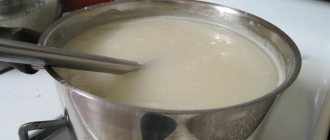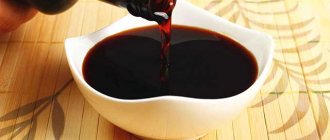Properties of agar-agar
Nutritional value and composition | Vitamins | Minerals
How much does agar-agar cost (average price per 1 kg)?
Moscow and Moscow region.
2060 rub.
Agar-agar is a plant analogue of edible gelatin. It is produced from eight different types of algae, brown and red. The scope of application of this substance is very wide. It is mainly used as a stabilizing component for some food products. By using food agar, you can treat yourself and your family to a variety of mouth-watering, jelly-like dishes with high nutritional value. The beneficial properties of agar-agar have long found their application in the culinary field, because, unlike gelatin, it does not lose its gelling properties even at very high temperatures. According to the quality, agar-agar is usually divided into two grades - the first (white, with a slightly grayish tint) and the highest (yellow).
In the food industry, agar-agar is used in the production of yoghurts, various desserts, ice cream, syrups, sorbets, cakes, fruit jellies, mayonnaise, sauces, soups and canned foods. Housewives were happy to take note of this natural gelatin substitute, since just a few grams of this substance can turn any liquid into a gel. If you mix agar-agar with water, the result is a very elastic and stable jelly. However, it should be remembered that agar-agar is absolutely insoluble in cold water. It is soluble only at high temperatures (above 90 degrees).
Often inexperienced cooks are upset that when using agar-agar for the first time they end up with a rather cloudy hot solution. Don't worry: when cooled to 40 degrees, it turns into a crystal clear and strong gel, which is also thermoreversible (meaning it can be heated again, and when cooled it will harden again). The calorie content of agar-agar is 301 kcal per 100 grams of product.
The jelly obtained by using agar-agar has neither odor nor taste, which makes it universal in use. Interestingly, for vegetarians this is an ideal replacement for gelatin, since it is of animal origin.
Application of Agar (agar-agar, E406)
Agar is used in the food industry as a gelling, stabilizing and viscosity-regulating agent. It is marked with the symbol E 406. It is a food additive, not a nutrient, because the human body only digests 10% of it. The gelling ability of agar is so great that it is used at a maximum concentration of 1.5%, so its consumption is very low.
Agar is the longest used colloid derived from plants. It has been used as a food additive in the Far East for over 300 years and in Western countries for over 100 years. This is an absolutely safe food supplement. This is confirmed by its many years of use, as well as the opinions of experts from FAO/WHO and FDA.
In what products can agar be used?
- sweets: jelly, marshmallows, fillings for sweets and cakes
- in marmalade
- in the bakery, for icing cakes and preventing them from drying out
- chocolate
- in yoghurts with a subtle sweet taste without the typical acidity of yoghurts
- in ice cream, milk drinks, puddings
- in cheese and other dairy products
- in sausages and low fat sausages, where it acts as a binder instead
- in canned meat
- in sauces and broths
- in liqueurs with alcohol
- for clarification of wine
Benefits of agar-agar
The benefits of agar-agar are simply obvious, as it is a rich source of magnesium and iron. In addition, this food product supplies our body with potassium, calcium, iodine, as well as oligoelements important for human health (for example, folic acid).
Nutritionists recommend introducing agar-agar into your diet if you are watching your figure, since it does not contain extra calories, while having laxative properties and satisfies hunger well (the so-called “saturation effect”).
In addition, the benefits of agar-agar are manifested in antibacterial properties and decongestant (decongestant) effect.
How to dilute agar-agar
There are several rules for using agar-agar:
- To activate the gelling properties, the algae powder must be boiled for about two minutes. This distinguishes agar-agar from gelatin, which should never be brought to a boil.
- To obtain a dense jelly with a pleasant taste, the following proportions should be observed: for 250 g/ml of product, you need to take 1 gram of agar-agar (about 0.5 tsp).
- It doesn’t really matter how you dilute agar-agar: in a cold liquid or a hot one. The main thing is that the powder is evenly distributed throughout the entire volume without lumps.
- Jelly based on algae powder hardens perfectly at room temperature within two hours; it does not need to be put in the refrigerator.
- If the liquid has already set and you didn’t have time to pour it, it doesn’t matter, the process is reversible. Heat the jelly and it will melt. In this way, you can even digest marmalade if you don’t like its original taste (insufficient sweetness, acidity, etc.)
Some people complain that agar jelly has an unpleasant taste. I know from experience that this is possible. But not because of the poor quality of the powder, but because of a violation of the agar-agar:liquid proportion.
A clear and not very pleasant taste of algae appears only if agar agar is diluted in an insufficient volume of liquid. The situation can be easily corrected - increase the volume of the gelled product until the aftertaste disappears. But be careful, if there is not enough agar, the jelly will turn out weak. Therefore, I recommend initially following the proportions indicated in the recipes.
a brief description of
The discovery of agar-agar is credited to the German microbiologist Walter Hosse, who first began to use algae for his research, and then his wife often prepared desserts with the addition of the gelling substance he obtained. Agar-agar soon spread throughout the world, becoming an indispensable culinary product.
Agar-agar is obtained from algae that grow in the Far Eastern seas. They are most common in the Sea of Japan and China.
The technology for producing agar-agar begins with the preparation of algae: they are thoroughly cleaned of shellfish, sand, small shells and other impurities, washed and soaked in water.
The next step is to boil the algae in an autoclave with the addition of hot water and alkali. After digestion, the resulting broth is filtered and cooled. The substance, frozen under the influence of low temperatures, is cut into pieces, additionally dehydrated and dried.
What does it look like?
Depending on the manufacturer and the purpose in cooking, agar-agar is produced in the form of thin plates or films, cereals, flakes or powder. A high-quality product is white or light brown in color, and when dissolved it becomes transparent.
How is it used?
Agar-agar is used in cooking for preparing main dishes and desserts. To achieve the desired consistency, the substance is added to the hot liquid and left for 15 minutes. After this, the liquid, vigorously stirring, is brought to a boil, and then cooled at room temperature and placed in the refrigerator for further solidification.
The melting point of agar-agar, at which it completely dissolves, is 95-100 °C. At a temperature of 30-35 °C, the substance hardens and acquires the consistency of a strong gel.
Agar-agar taste
Table
| element name | quantity | daily norm | |
| The nutritional value | |||
| Calorie content | 301 mg | ||
| Squirrels | 4 g | ||
| Carbohydrates | 76 g | ||
| Fats | 0 | ||
| Vitamins | |||
| Vitamin B3 | 0 | 15.059 mg | |
| Vitamin B2 | 0 | 1.329 mg | |
| Vitamin PP (NE) | 0.664 mg | 15.059 mg | |
| Vitamin B1 | 0 | 1.159 mg | |
| Vitamin E (TE) | 0 | 10.882 mg | |
| Vitamin C | 0 | 69.118 mg | |
| Provitamin A | 0 | 5 mg | |
| Vitamin A (VE) | 0 | 0.753 mg | |
| Vitamin B5 | 0 | 3.794 mg | |
| Vitamin B6 | 0 | 1.512 mg | |
| Vitamin B9 | 0 | 0.286 mg | |
| Vitamin H | 0 | 0.034 mg | |
| Vitamin A | 0 | 0.753 mg | |
| Vitamin E | 0 | 15 mg | |
| Vitamin B12 | 0 | 3 mcg | |
| Vitamin B4 | 0 | 500 mg | |
| Vitamin D | 0 | 0.011 mg | |
| Vitamin K | 0 | 0.085 mg | |
| Macronutrients | |||
| Calcium | 1 mg | 987.5 mg | |
| Magnesium | 0 | 276.177 mg | |
| Sodium | 0 | 948.824 mg | |
| Potassium | 0 | 1.807 g | |
| Phosphorus | 0 | 852.941 mg | |
| Sulfur | 0 | 1 g | |
| Silicon | 0 | 30 mg | |
| Microelements | |||
| Iron | 0 | 13.75 mg | |
| Chlorine | 0 | 2.3 g | |
| Copper | 0 | 0.806 mg | |
| Manganese | 0 | 2 mg | |
| Fluorine | 0 | 3 mg | |
| Bor | 0 | 1.4 mg | |
| Aluminum | 0 | 40 mg | |
| Titanium | 0 | 0.85 mg | |
| Strontium | 0 | 1.5 mg | |
| Iodine | 0 | 0.131 mg | |
| Zinc | 0 | 9.706 mg | |
| Chromium | 0 | 0.034 mg | |
| Molybdenum | 0 | 0.07 mg | |
| Vanadium | 0 | 0.01 mg | |
| Cobalt | 0 | 0.1 mg | |
| Nickel | 0 | 0.1 mg | |
| Rubidium | 0 | 0.2 mg | |
| Lithium | 0 | 0.2 mg | |
| Selenium | 0 | 0.04 mg | |
| Tin | 0 | 0.7 mg | |
| Zirconium | 0 | 0.5 mg | |
| Other elements | |||
| Alimentary fiber | 0 | ||
| Organic acids | 0 | ||
| Water | 18 g | ||
| Mono- and disaccharides | 0 | ||
| Ash | 2 g | ||
| Alcohol | 0 | ||
| Starch | 76 g | ||
| Saturated fatty acids | 0 | ||
| Cholesterol | 0 | ||
| Unsaturated fatty acids | 0 | ||
This table shows the average norms of elements for an adult.
Use in cooking
The main area of use of agar-agar in cooking is confectionery. It is used to make marshmallows and marmalade, marshmallows and candies, jams, soufflés, jelly and ice cream. Recipes for bird's milk cake, cheesecake, pudding and panna cotta include agar agar.
In addition to desserts, the gelling agent is added to main dishes, such as fish or meat jellies.
Agar-agar is often used in cosmetology. Based on it, both professional and home masks are prepared for the face and hair.
Face masks
The simplest mask, which will soften the skin and saturate it with nutrients, is made by diluting agar-agar in hot water: a tablespoon of the substance is slowly poured with water until completely thickened. The resulting gel is applied to previously cleansed facial skin for half an hour and then washed off with warm water.
1-1.5 tsp. agar-agar mixed with cucumber or lime juice will help against wrinkles. Apply the mask to the face for 15-20 minutes and then wash off with a damp sponge. Regular use of this product will help avoid wrinkles and make the skin soft and velvety.
Hair masks
Masks with agar-agar give hair extraordinary silkiness and softness, eliminate fragility, and fight split ends.
The easiest way to prepare agar-agar is in a water bath, keeping the proportions of water and substance 3:1, respectively. When you add burdock oil to the mixture, the mask will become an effective means of combating hair loss. If desired, you can mix the gel with aromatic oils. A mask with a gelling substance is applied to the entire length of the hair and wrapped in polyethylene or a towel. After half an hour, you can wash off the mixture with warm water.
Agar-agar is the best gelling agent for making desserts. It is easy to use, and the resulting dish will not only be tasty, but also healthy.
Agar-agar is used to prepare various jams, marmalade, soufflés, marshmallows, confitures, marshmallows, and is also used as a filling for sweets, included in jelly, ice cream, and bird's milk sweets. In addition, this product is added in the manufacture of canned fish, meat, vegetables and fruits, baked goods, mayonnaise, beer, condensed milk, chewing gum, and sometimes even to clarify drinks.
Curd cake on agar-agar
Cottage cheese is necessary for any person because it contains a lot of calcium. But it is very difficult to persuade children to eat this healthy product. But cottage cheese can be hidden inside a delicious dessert, and children will not even suspect that they are eating it. And it’s very difficult to refuse cake, because you can barely feel this product in it, and cocoa and banana make it completely unnoticeable.
Desserts with agar-agar are very popular. This ingredient can be purchased in special confectionery stores or in the supermarket. Sometimes it can be replaced with gelatin, but gelatin can give the dessert a less than pleasant taste. Keep in mind that gelatin will only set in the refrigerator, but agar-agar needs to be worked very quickly because it begins to harden at room temperature.
Ingredients for the agar-agar soufflé recipe:
- 100 grams of low-fat soft cottage cheese.
- One and a half tablespoons of honey.
- One banana.
- One tablespoon of cocoa.
- A teaspoon of agar-agar.
- A tablespoon of cocoa.
- Half a teaspoon of vanilla sugar.
- 100 g of water.
For chocolate glaze:
- One and a half tablespoons of cocoa powder.
- One tablespoon of honey.
- One dessert spoon of vegetable oil.
- Four tablespoons of water.
How is it different from other gelling agents?
To choose the right gelling agent for specific culinary needs, you should understand how agar-agar differs from gelatin and pectin.
From gelatin
The main difference between agar-agar and gelatin is the raw material from which these substances are produced: the first is made from algae, and the second from animal collagen. In addition, the substances have other differences:
- calorie content (0 kcal agar-agar versus 335 kcal gelatin);
- speed of hardening (agar-agar hardens much faster than gelatin);
- consumption (agar-agar is needed 2 times less than gelatin);
- taste (unlike gelatin, which has a rich taste, agar-agar does not overwhelm other products).
From pectin
Pectin has a slightly sour taste and is therefore considered the best solution for yoghurts, jams, mousses and marmalade, to which it gives a viscous, soft texture. Neutral-tasting agar-agar is better suited for jelly, marmalade and marshmallows, where a dense consistency is important.










